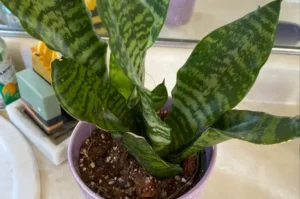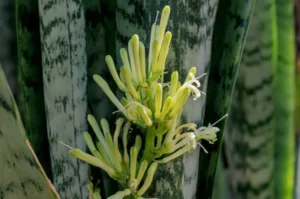Snake plants, also known as Sansevieria or Dracaena trifasciata, are well-loved for their low-maintenance care and unique upright leaves. While many grow them for their ornamental foliage and air-purifying qualities, some are surprised to learn that snake plants can also produce flowers. But when exactly do they bloom? If you’ve never seen your snake plant flower, you’re not alone — it’s a rare but fascinating event.
Let’s explore the flowering habits of snake plants, when you can expect them to bloom, what the flowers look like, and how you can encourage yours to flower.
Do Snake Plants Flower?
Yes, snake plants do flower, though it’s uncommon, especially indoors. The flowers grow on a long spike called an inflorescence, often rising above the leaves. These flowers are small, usually white or cream-colored, and have a delicate fragrance, especially at night.
While snake plants are more popular for their leaves than blooms, flowering is a natural part of their life cycle under the right conditions.
Typical Flowering Season of Snake Plants :
When Do Snake Plants Bloom?
The typical flowering season for snake plants is spring to early summer. However, the blooming can vary depending on the plant’s environment and care.
In warm climates or indoor spaces with stable temperatures and indirect sunlight, flowering can happen from late March to July. Outdoor snake plants growing in tropical or subtropical zones may bloom earlier due to more natural light and airflow.
Factors That Affect Flowering Time
Many snake plant owners go years without seeing a single bloom. That’s because flowering isn’t guaranteed—it depends on several factors:
1. Age of the Plant
Mature snake plants are more likely to flower than younger ones. It may take several years for a plant to reach blooming age.
2. Pot Bound Conditions
Interestingly, snake plants are more likely to bloom when slightly root-bound. When the roots are tight in the pot, the plant feels “stressed,” which may trigger flowering.
3. Light Exposure
While snake plants can survive in low light, they need bright, indirect sunlight to flower. A sunny windowsill is ideal for encouraging blooming.
4. Watering Schedule
Snake plants prefer to dry out between waterings. Overwatering can lead to root rot and prevent flowering. A well-balanced watering schedule helps promote healthy growth and potential blooming.
5. Temperature and Season
A warm, stable environment with minimal temperature drops is key. Snake plants are tropical, so they thrive in temperatures between 70°F and 90°F (21°C to 32°C).
What Do Snake Plant Flowers Look Like?
Snake plant flowers are delicate and grow on tall stalks, sometimes over 2 feet tall. The blooms resemble small lilies or honeysuckle and release a sweet, jasmine-like scent in the evening. They typically last for a few weeks.
Fun Fact:
The flowers produce sticky nectar, which can drip down the leaves. While it’s not harmful, it can attract insects if left unattended.
How to Encourage Your Snake Plant to Flower
Although there’s no guaranteed method to make a snake plant bloom, here are a few tips that might help:
- Keep the plant slightly root-bound: Avoid frequent repotting.
- Place it in a bright spot: Near a window with filtered sunlight.
- Follow a proper watering routine: Water only when the soil is dry.
- Use a mild fertilizer: Feed your plant with a balanced fertilizer during the growing season (spring and summer).
- Maintain a warm environment: Protect the plant from cold drafts or temperature drops.
Remember, some snake plants never flower, and that’s okay. The foliage is the main attraction, and flowering is just a bonus.
Common Myths About Snake Plant Flowering :
Myth 1: Only outdoor snake plants can flower
False. Indoor snake plants can flower if they receive adequate light and care.
Myth 2: Flowering means the plant is dying
No. Flowering is a normal part of the plant’s life cycle and doesn’t necessarily indicate stress or death.
Myth 3: Snake plant flowers are toxic
While snake plants are mildly toxic to pets if ingested, the flowers themselves are not harmful to humans or pets unless eaten.
Frequently Asked Questions (FAQs)
Do all varieties of snake plants flower?
Yes, all varieties can potentially flower, though the appearance and frequency of blooms may vary slightly among cultivars.
How often do snake plants bloom?
Most snake plants bloom once a year, if at all. Some may never bloom, especially if kept in low-light conditions.
Can I make my snake plant bloom faster?
You can encourage blooming by providing bright light, limiting pot space, and maintaining good care practices. But there’s no surefire way to speed up the process.
Should I cut the flower stalk after it blooms?
Yes, once the flowers have dried up, you can safely trim the stalk at the base. This helps the plant focus its energy on leaf growth.
Conclusion
While snake plant flowers are rare, they’re a delightful surprise when they do appear. The typical flowering season is between spring and early summer, but the conditions need to be just right. Mature plants in bright light, slightly root-bound, and well-cared-for are more likely to reward you with their subtle blooms.
Even if your snake plant never flowers, it’s still one of the most rewarding houseplants you can grow — tough, beautiful, and full of personality. Treat it well, and you might just catch it in bloom one day.






